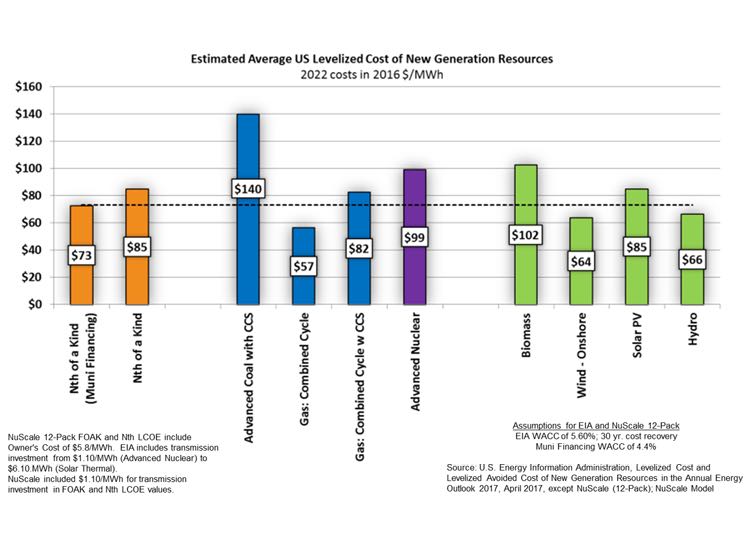forum
library
tutorial
contact

Little Reactor is a Big Edge
in Nuclear Energy's Global Race
by Jim Conca
Tri-City Herald, May 26, 2018
|
the film forum library tutorial contact |

|
Little Reactor is a Big Edge
by Jim Conca
|
 NuScale Power continues on track to build the first small modular nuclear reactor in America -- even faster than expected. Two weeks ago, NuScale's design completed the Phase 1 review of their design certification application by the U.S. Nuclear Regulatory Commission.
NuScale Power continues on track to build the first small modular nuclear reactor in America -- even faster than expected. Two weeks ago, NuScale's design completed the Phase 1 review of their design certification application by the U.S. Nuclear Regulatory Commission.
That's a huge deal because Phase 1 is the most intensive phase of the review, taking more hours and effort than the remaining five phases combined. NuScale sailed through in a year, faster than any design in history. NRC's final approval is expected by September 2020.
The first customer is certainly ready. Utah Associated Municipal Power Systems (UAMPS) will own the first NuScale plant, a 12-module SMR or 12-pack, and place it at the Idaho National Laboratory. It will be operated by our own Energy Northwest, one of the most effective and experienced nuclear operators in the world.
This first application will take advantage of the SMR's ability to completely help the Utah wind farms, removing the need for natural gas or hydroelectric to back them up.
In preparation for a serious nuclear expansion in the 2020s, NuScale has built another of its amazing 12-module control room simulators here in Richland. NuScale's is the first control room to control more than one reactor at a time.
"Having visited the NuScale control room simulator in Corvallis, Oregon, I am thrilled to have a similar facility here in the Tri-Cities," said Senator Sharon Brown, R-Kennewick, the state Legislature's leading advocate for SMR technology and nuclear power.
"Promoting the growth of the small modular reactor industry in Washington could mean thousands of good-paying, family-wage jobs in construction, manufacturing and other related high-tech fields," she said.
Brown is the sponsor of several measures aimed at making Washington more attractive to SMR manufacturers, including Senate Bill 5475, which provides a business-and-occupation tax incentive for the production of small nuclear reactors.
NuScale's reactor is also America's best chance to compete in the global SMR market, and puts the U.S. on a path to beat foreign competitors like Argentina, China, Russia and South Korea. Up to 75 GW of electricity will come from operating SMRs around the world by 2035, the equivalent of more than 1,000 NuScale Power Modules, bringing the market up towards a trillion dollars.
And America should lead that effort.

The U.S. Department of Energy agreed, and on April 27th awarded NuScale $40 million to support bringing their SMR to market. Its first plant will cost just under $3 billion and take half the time to build, giving an overnight capital cost of $5,078/kWe. The total life-cycle cost to produce electricity with this SMR is below that of most other energy sources, just slightly above hydro and natural gas.
But the real power of SMRs are the fact that they can't melt down. This is a big deal. It means the reactor just won't melt down or otherwise cause any of the nightmares people think about when imagining the worse for nuclear power.
It just shuts down and cools off. No humans or computers are needed to intervene, no back-up power, no pumps, and no additional water for cooling. Plus, no one can hack this reactor. It doesn't even need to shut down to refuel.
The components of the NuScale reactor can all be manufactured in a factory with medium-sized forges, something we still have here in the U.S., prior to shipping and assembly at the site.
Traditional nuclear reactors are between about 600 and 1,200 MW, but these small power modules are 50 MW each. A 12-pack produces enough zero-carbon electricity to power the entire Yakima and Columbia basins, including Hanford's future vitrification plant, which at present is set to consume 43,000 gallons of diesel fuel a day.
A single NuScale nuclear power module is 76 feet tall and 15 feet in diameter, and a 12-pack sits in a plant covering less than a tenth of a square mile, or about 60 acres. In comparison, it takes at least 130,000 acres, or about 200 square miles, of wind farms to produce the same amount of energy.
learn more on topics covered in the film
see the video
read the script
learn the songs
discussion forum
